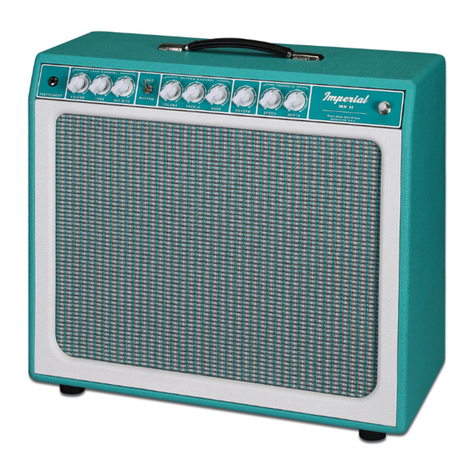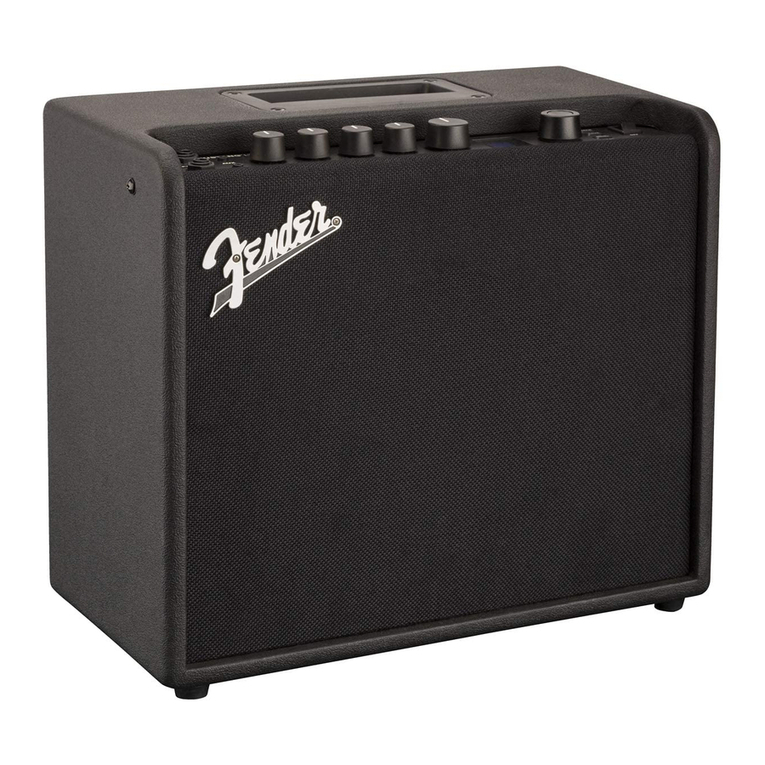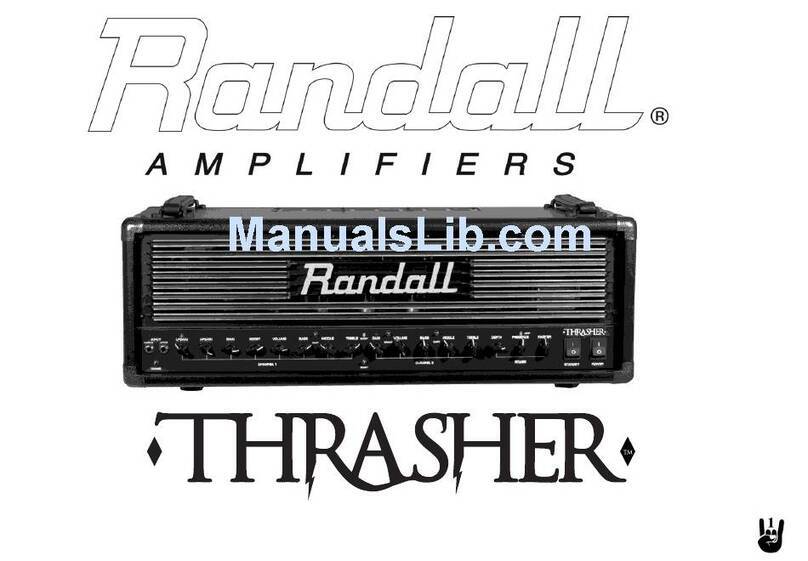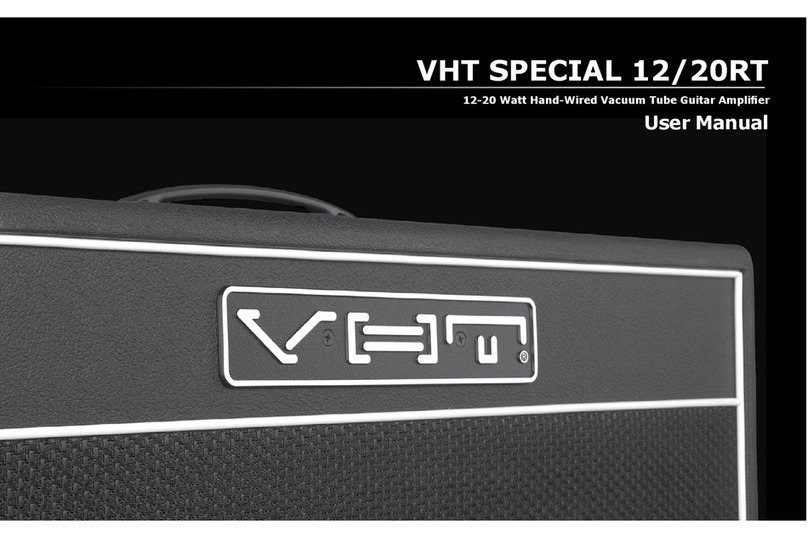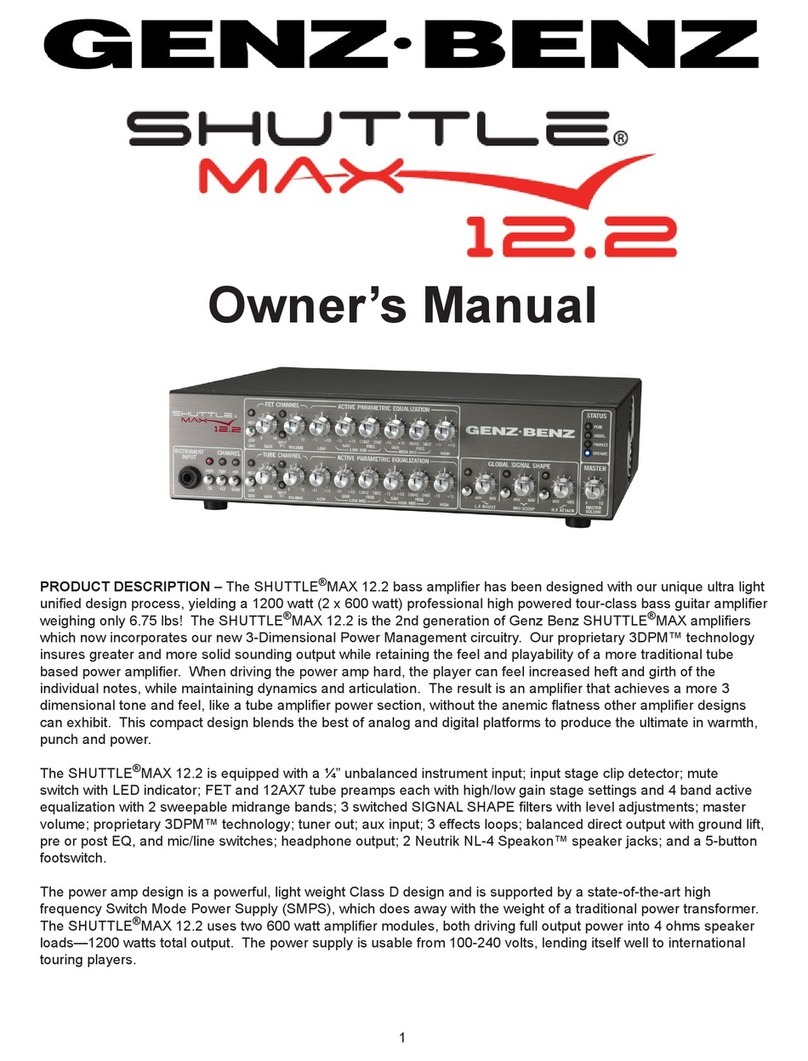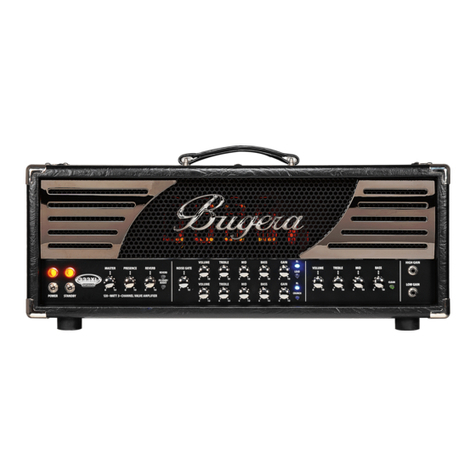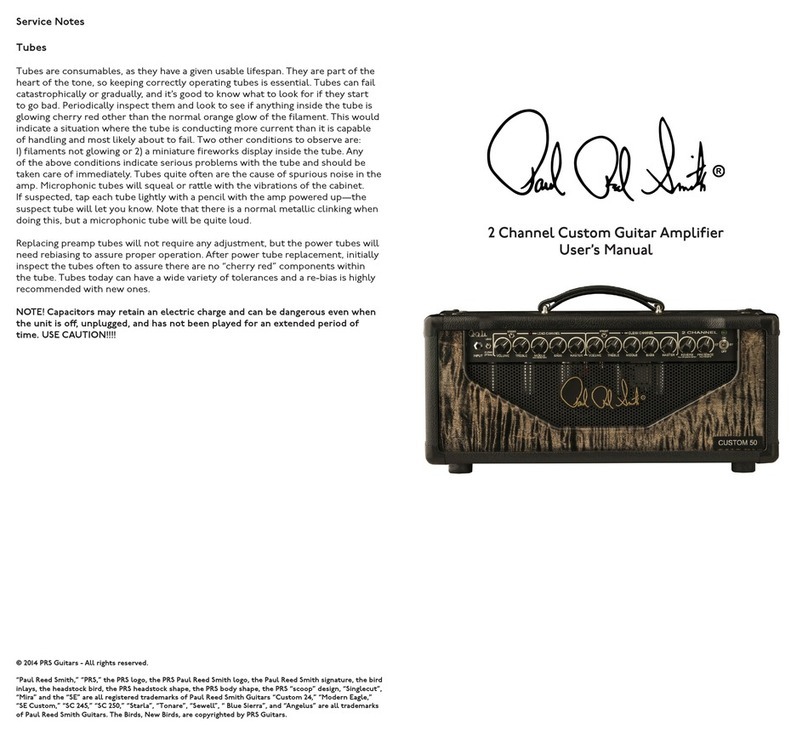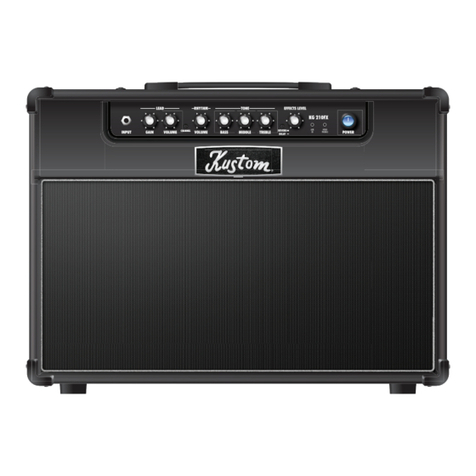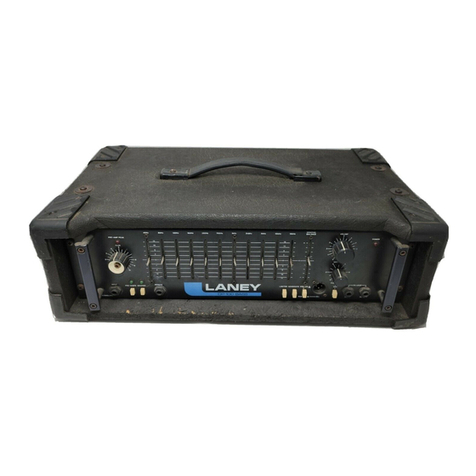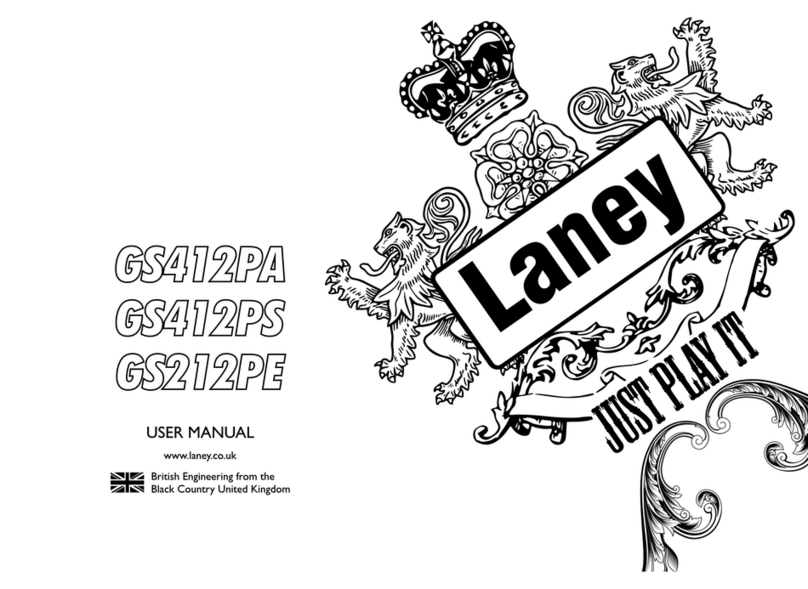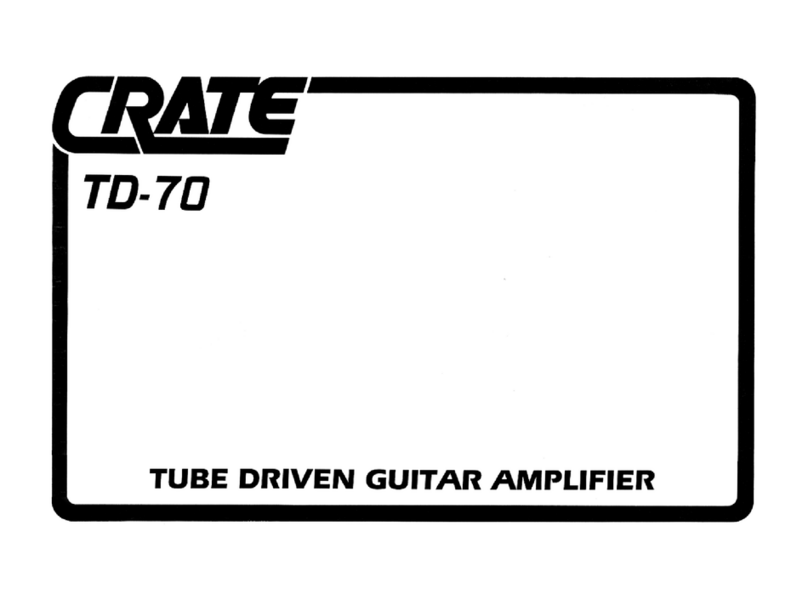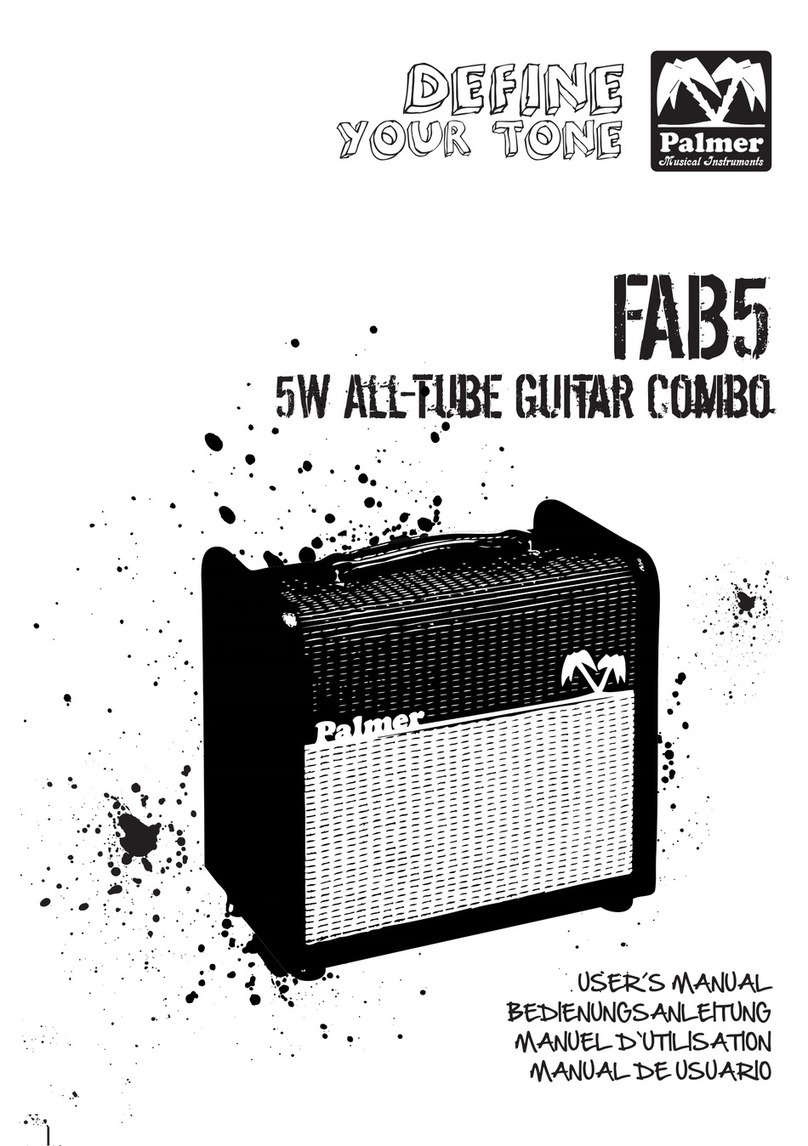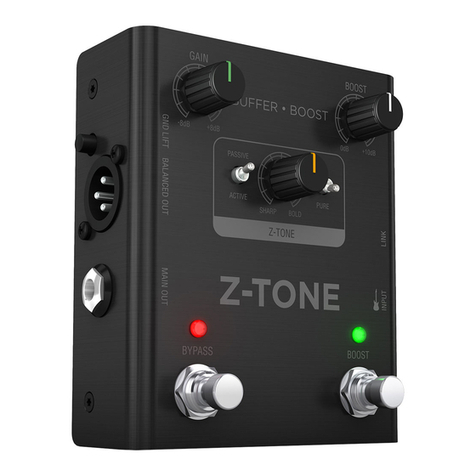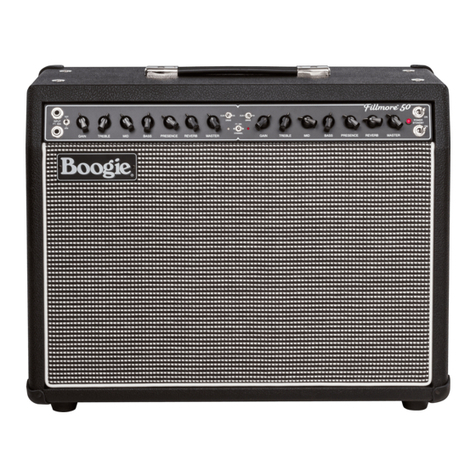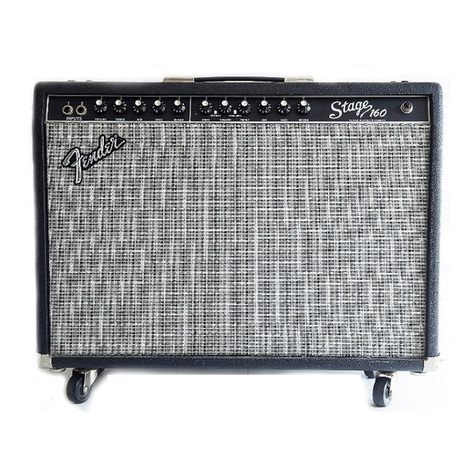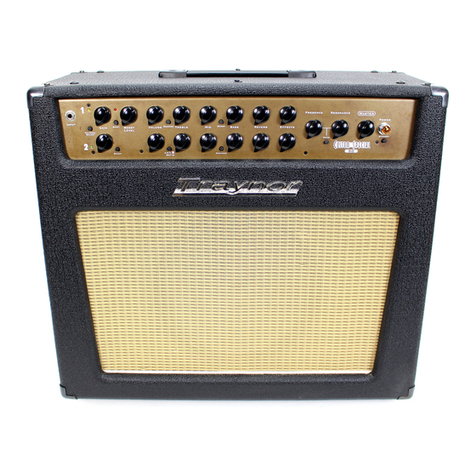Tone King 20th Anniversary Imperial User manual

Tone King
Tone King Tone King
Tone King
“20
“20“20
“20th
thth
th Anniversary Imperial”
Anniversary Imperial” Anniversary Imperial”
Anniversary Imperial”
User’s Manual
User’s ManualUser’s Manual
User’s Manual
1.0 7/19/2013
Tone King Amplifiers
A division of Premier Builders Guild LLC
4401 Eastern Avenue, Bldg 45 2A, Box 38
Baltimore, Maryland 21224
www.toneking.com
mail@toneking.com

1
Note fr
Note frNote fr
Note from the Builder
om the Builderom the Builder
om the Builder
Thank you for choosing Tone King’s “20th Anniversary Imperial” guitar amplifier. The
Imperial was the very first pro uction mo el built by Tone King, an the 20th
Anniversary Imperial is a very special ren ering of this classic mo el.
I esigne the Imperial back in 1992-1993,
with the i ea of combining a clean rhythm
tone inspire by a vintage blackface Deluxe
Reverb with a lea tone inspire by a Twee
Deluxe. Then, as now, my esign
metho ology involve not simply pro ucing a
clone of those vintage amps, but something
much more. The i ea was to econstruct the
soun of certain inspirational amps - i entify
the characteristics that make them great, but
also i entify the characteristics that I thought
coul be improve . Then, the esign process
became a matter of using any means possible
to eliver more of the “goo ” characteristics
an less of the “ba ” ones. At the time,
information about the construction of vintage
amps like these was har to come by, so I starte from a blank slate, gui e solely by
my knowle ge of engineering, technical skills, woo working, an most importantly
critical listening.
I eventually came to realize that getting the
soun an feel I was after woul require more
than just getting the electronics right – an equal
amount of effort woul have to be put into the
speaker cabinet esign. A lot of the great tonal
characteristics of those genuine vintage amps
came not from the circuitry, but from the
particular qualities of the speaker cabinet. The
ol cabinets ha a certain soun quality that
was lacking in newly ma e cabinets, an I put
consi erable effort into un erstan ing how to tune a cabinet to achieve these qualities
in a newly ma e cabinet. The photo at right shows a stack of test baffle boar s from
those early experiments, showing just a few of the many types of woo that I
experimente with in or er to achieve that won erful soun an feel of a genuine 50
year ol cabinet.
In the en , the Imperial turne out to have the right soun , right power level, an right
features to make it a very successful small club amp for the past 20 years since its’
intro uction. I thank you for your purchase of this special version of the Imperial, an
I hope you enjoy playing it as much as I o.
Best Regar s,
Mark Bartel
Tone King Amplifiers, a ivision of Premier Buil ers Guil LLC

2
Safety Instructions (Important !)
Safety Instructions (Important !)Safety Instructions (Important !)
Safety Instructions (Important !)
1. Please rea these instructions, an keep them for reference.
2. Please follow all instructions escribe here.
3. Do not use this apparatus near water.
4. Clean only with a ry cloth.
5. Do not block any ventilation openings.
6. Do not operate near any heat sources such as ra iators or heat registers.
7. Protect the power cor from being walke on or pinche , particularly at the plugs
an at the point where they exit from the apparatus.
8. Only use attachments/accessories specifie by the manufacturer.
9. Unplug this apparatus uring lightning storms or when unuse for long perio s of
time.
10. Refer all servicing to qualifie service personnel. Servicing is require when the
apparatus has been amage in any way. For example, if the power supply cor or
plug is amage , liqui has been spille or objects have fallen into the apparatus, the
apparatus has been expose to rain or moisture, oes not operate normally, or has
been roppe .
11. CAUTION: To isconnect the unit completely from the MAINS, unplug the unit.
Turning the power switch off oes not isconnect the unit completely from the MAINS.

3
Contents
ContentsContents
Contents
1. Front Panel Controls 4
Two Preamp Channels – Lea an Rhythm
4
Rhythm Channel 4
Lea Channel 5
Reverb 6
Tremolo (Rate & Depth) 6
2. Back Panel Controls 7
AC Power 7
Fuse 7
Power Switch, Stan by Switch 7
Footswitch 7
Speaker Jack 8
Attenuation Controls 8
Notes on Using the Attenuator 9
3. Tube Installation and Replacement 10
Choice of Tube Types an Bran s 10
12AX7 Tubes 10
6V6 Tubes 11
Alternate Tube Choices 11
Installing Tubes 12
Replacing Output Tubes 12
Tube Quality 12
4. Warranty 13

4
1. ront Panel Controls
1. ront Panel Controls1. ront Panel Controls
1. ront Panel Controls
Two Preamp Channels
Two Preamp Channels Two Preamp Channels
Two Preamp Channels —
——
— Lead and Rhythm
Lead and Rhythm Lead and Rhythm
Lead and Rhythm
The Imperial has two separate preamplifier channels, each with its own unique voicing.
You can switch between the channels with either the “Lea /Rhythm” switch (on the
front panel) or with the “Channel” switch on the footswitch. When using the footswitch,
you shoul set the front panel switch to the “Rhythm” position. You’ll notice that the
LED on the footswitch in icates the channel selecte . When the LED is lit, the Lea
channel is selecte . When the LED is not lit, the Rhythm channel is selecte .
Rhythm Channel
Rhythm ChannelRhythm Channel
Rhythm Channel
The Rhythm channel inclu es controls for Volume, Treble, an Bass. This channel is
esigne to eliver a “vintage 1960’s clean tone” – the type of tone you might associate
with a well known bran of amplifier ma e in California uring that perio . This tone
is characterize by a crisp, present top en , a slightly “scoope ” mi range, an a full
bottom en .
The Bass an Treble controls act much like they woul on a genuine vintage amp of
this type. The Imperial is a bit unique in that you’ll fin a wi e range of usable tones at
just about any setting of the Bass an Treble controls, but here are a few sample
settings to get you starte :
1960s Clean Tone
1960s Clean Tone 1960s Clean Tone
1960s Clean Tone
Volume Treble Bass
3 4 6
“Pushed” Clean Tone
“Pushed” Clean Tone “Pushed” Clean Tone
“Pushed” Clean Tone
Volume Treble Bass
6 3 3

5
Lead Channel
Lead ChannelLead Channel
Lead Channel
The Lea channel starts out with a Twee style preamp, which rives a proprietary
tone-shaping circuit built aroun the Mi -Bite control, a unique Tone King feature.
This proprietary circuit transforms the basic twee tone to more of a crunchy rock tone
as you turn up the mi -bite control. This is accomplishe by simultaneously tightening
up the bass, rolling off the very high frequencies, increasing the gain, an eveloping a
pronounce upper mi range peak. The Mi -Bite control is the key to ialing in your
own particular soun on the lea channel, so you may want to experiment an observe
its effect as you rotate it from 1 to 9.
When you are using the attenuator to re uce the volume of the lea channel, you’ll
notice that the speaker acts ifferently at low volume than it oes at high volume. At
low volume, you on’t get the benefit of speaker breakup an compression to smooth
an roun out the istortion tone. A goo way to compensate for this is to turn own
the Tone control a bit, though the compensation necessary epen s a lot on the
acoustical environment. You may or may not fin it necessary to make a justments of
this sort.
Here are a few sample settings which emonstrate just a few of the tones available with
the Lea channel:
Old Style T
Old Style TOld Style T
Old Style Tweed Clean
weed Cleanweed Clean
weed Clean
Volume Tone Mid-Bite
3 5 1
Cranked Tweed
Cranked TweedCranked Tweed
Cranked Tweed
Volume Tone Mid-Bite
5 4 1.5
Rock Grind
Rock GrindRock Grind
Rock Grind
Volume Tone Mid-Bite
7 5 5
Thick, Chunky Mids
Thick, Chunky Mids Thick, Chunky Mids
Thick, Chunky Mids —
——
— Hot Tweed
Hot Tweed Hot Tweed
Hot Tweed
Volume Tone Mid-Bite
7 5 9

6
Reverb
ReverbReverb
Reverb
The Imperial inclu es a built in 2-spring, tube- riven reverb circuit. Reverb is applie
to both the Rhythm an Lea channels. In or er to compensate for the higher gain of
the Lea channel, the reverb rive is re uce slightly on the Lea channel. This
re uction helps to match the reverb level when switching between preamp channels,
when the Lea channel is being riven har an the Rhythm channel is set for a clean
tone.
The Reverb level is controlle by the front panel Reverb control, which a justs the
amount of the reverb signal which is mixe into the signal path.
Tremolo (Rate & Depth)
Tremolo (Rate & Depth)Tremolo (Rate & Depth)
Tremolo (Rate & Depth)
The Imperial’s tremolo circuit is a mo ifie form of the ol -fashione “bias mo ulation”
tremolo circuit. This circuit achieves the tremolo effect by varying the bias of the
output tubes. This type of tremolo was use in all Tone King amps going back to 1993.
However, the 20th Anniversary Imperial uses a mo ifie form of this circuit which
virtually eliminates the “thumping” an other sonic effects that are typical for this type
of effect.
This type of tremolo circuit gives you a nicely roun e effect, but it is quite subtle when
compare to an opto-coupler tremolo (as woul be foun in, for example, a Fen er Twin
Reverb).
The “Depth” control varies the intensity of the mo ulation effect, an the “Rate” knob
controls the spee of the effect.
If the footswitch is not being use , then the tremolo circuit is active all the time, so you
will nee to turn the “Depth” knob all the way own if you o not wish to use tremolo.
When the footswitch is plugge in, you can turn the tremolo on an off with the
footswitch. An LED shows the status of the effect (LED on = tremolo on)

7
2. Back Panel Controls
2. Back Panel Controls2. Back Panel Controls
2. Back Panel Controls
AC Power
AC PowerAC Power
AC Power
Always use a groun e AC cor , an make sure that a proper groun connection is
supplie to the amp. Never attempt to lift or efeat the groun connection to the amp.
use
useuse
use
A stan ar 2A slo-blo fuse (style 3AG) shoul be use .
Power Switch, Standby Switch
Power Switch, Standby SwitchPower Switch, Standby Switch
Power Switch, Standby Switch
When powering up the amp, you shoul start with both the Power an Stan by
switches in the "off" position.
First, turn on the Power switch. This will apply power only to the tube filaments an
the low-voltage circuitry.
After turning on the Power switch, allow the tubes to warm up for about 1 minute, then
turn on the Stan by switch.
The power- own sequence is not as important as the power-up sequence. When
turning the amp off, you may turn Power off before Stan by, or turn Stan by off before
Power, or turn them both off at the same time.
ootswitch
ootswitchootswitch
ootswitch
Connect the footswitch to the amp with the supplie cable, or with any stan ar ¼”
TRS (Stereo) -to- ¼” TRS (Stereo) cable.
The footwitch allows you to control both the preamp channel selection an the tremolo
on/off. LEDs in icate the current switching status, as follows:
Channel switch: LED on = Lea channel
Tremolo switch: LED on = Tremolo on
When using the footswitch, make sure to set the front panel Channel switch to the
Rhythm position.

8
Speaker Jack
Speaker JackSpeaker Jack
Speaker Jack
The Imperial has a single speaker jack with an impe ance of 8 Ohms. If you wish to
use an extension cabinet, it’s best to use an 8-ohm cabinet. You can connect it with a
stan ar ¼” mono speaker cable by pulling out the plug from the internal speaker, an
plugging the cable into the speaker jack.
If esire or necessary, you may safely mismatch the impe ance by as much as
oubling or halving the selecte impe ance. Mismatching beyon this is not
recommen e . For example, you may you may safely use a total speaker loa as low as
4 ohms or as high as 16 ohms.
Attenuation Control
Attenuation ControlAttenuation Control
Attenuation Control
The Imperial contains a built-in Ironman precision attenuator with a single attenuation
control. The attenuator allows you to re uce the volume level of the amplifier while
allowing its output tubes to operate at full output power, for natural power tube
over rive an istortion. This attenuator uses transformer coupling an a precision
tune reactive loa to best preserve the natural tone an feel of the amp, even at very
low volume. This is the same general approach use in the highly regar e Ironman
stan alone attenuator.
There are many ifferent approaches that can be use to generate over riven an
istorte tones as a low volume. For example, master volume circuits, or a power
re uction scheme such as Lon on Power Scaling have both use successfully on
various amp mo els of other bran s. However, for the more vintage soun ing tones
that the Imperial is esigne to achieve, a goo quality attenuator such as the built-in
Ironman is the best way to preserve tone an feel at very low volume.
The attenuation control etermines the amount of power sent to the speaker, but oes
not affect the operation of the output stage of the amplifier itself. The attenuator
absorbs an issipates any excess power generate by the output tubes that is not sent
to the speaker.
The attenuator is internally connecte between the amplifier output an the speaker
jack – the same way an external attenuator woul be connecte . However, the input of
the attenuator is not accessible, so you cannot use the built-in Ironman attenuator to
attenuate the output of some other amplifier.
This particular variation of the Ironman is esigne with one attenuation control, which
acts globally to control the volume level no matter which preamp channel is selecte .

9
Notes on using the attenuator
Notes on using the attenuatorNotes on using the attenuator
Notes on using the attenuator
At the 0 b setting, the attenuator is completely bypasse – the speaker is connecte
irectly to the output transformer secon ary, an the attenuator circuitry is completely
isconnecte from the signal path.
Although the Ironman attenuator oes an excellent job of re ucing output power
without changing the tone of the amp’s circuitry, there are other variables in play at
lower volume which o result in some apparent tone change. Here are a few factors
that you shoul be aware of -
Speaker breakup an compression is a big part of the tone an feel of the amp when
playe at high volume. At low power settings, the speaker respon s ifferently, an
oes not break up an compress as it oes at high power.
The ear’s natural response curve varies at ifferent volume levels, which changes the
way you perceive soun s at ifferent volume levels. Quieter soun s ten to give the
impression of having less bass content.
At lower volume, there is a ten ency to hit the guitar strings har er an play more
aggressively than you woul if the amp were tune up very lou . It may take some time
to get use to maintaining your playing style at re uce volume.

10
3. Tube Installation and Replacement
3. Tube Installation and Replacement3. Tube Installation and Replacement
3. Tube Installation and Replacement
Choice
Choice Choice
Choice of Tube Types and Brands
of Tube Types and Brands of Tube Types and Brands
of Tube Types and Brands
I currently recommen the following tube types:
No. Type and Brand Function
V1 Voshko 12AX7VKA Stage 1 (Rhythm+Lea ), Stage 2 (Lea )
V2 Voshko 12AX7VKA Stage 2 (Rhythm), Stage 3 (Lea )
V3 EH 12AT7 Reverb Driver
V4 Voshko 12AX7VKA Reverb receiver
V5 Voshko 12AX7VKA Phase Inverter
V6-V7 EH 6V6GT Output Tubes
V8 Sovtek 5AR4 Rectifier
The tube bran s shown above are my own preferences. You may want to use other
bran s, to tailor the soun to your own tastes. Here are a few notes on the various
bran s available to ay:
12AX7 Tubes:
I prefer the soun of the Voshko 12AX7VKA – it has a nice warm, full, well-balance
soun with a soft, less stri ent top en . Its only negative aspect is that it can be less
quiet than some other bran s.
EH 12AX7s are very similar to Tung Sol 12AX7s – both are very quiet with very low
microphonics an are a bit on the bright si e, with an exten e top en . Tung Sols
may be just a bit warmer than EHs.
The Svetlana 12AX7, a short-plate tube, has nearly the clarity of the 12AX7EH, an
slightly more bottom en , but is a bit congeste in the mi range. Years ago, I ha
selecte this bran as the bran of choice for the Meteor/II amp, but later change to a
combination of the 12AX7EH an the 12AX7LPS.
The EI 12AX7, a long-plate tube, is a very warm, huge soun ing tube, with a very NOS
character. It’s the next best thing to NOS, an actually better than some NOS bran s.
However, it is extremely microphonic, an can therefore be ifficult to use.
Sovtek 12AX7LPS – this long-plate 12AX7 has a big, warm soun with nearly the epth
an NOS-like quality of the EI 12AX7, with the EI being a bit more balance soun ing,

11
an the Sovtek being a bit veile on the top en . However, this long plate tube is
nearly as microphonic as the EI, an shoul not be use for the 1st gain stage.
6V6 Tubes:
I prefer the EH 6V6 for its warmth, smooth compression, an balance top en . Here
are my impressions of the essential characteristics of some other commonly available
6V6s:
Tung-Sol 6V6: In the Imperial, the Tung Sol 6V6 soun s a bit more like a NOS tube,
but has a har er feel, more glaring top en , an a grittier over rive than the EH 6V6.
JJ 6V6: In the Imperial, the JJ 6V6 has a bigger, fatter soun than the EH, but is a bit
less lively soun ing, an has a more mute top en . It soun s a bit more like a 6L6
than a 6V6.
Alternate Tube Choices You May Want to Try
Re ucing Gain: If you fin the preamp too gainy, an you fin that you’re setting the
volume controls own quite low to get sufficient clean hea room, you may want to try
swapping in a 12AU7 in the V2 position. You can re uce the gain further by swapping
a 12AU7 into the V1 position as well.
A ing Sag / More Compression: If you’ like a little less output power, an a little
looser feel, you might try changing the rectifier tube to a 5Y3. My preference is an ol
NOS RCA 5Y3 – these soun better than current pro uction 5Y3s.

12
Installing Tubes
When installing tubes, you may fin it helpful to lay the amp on its face (speaker
pointing towar the groun ), on a table, an shine a light irectly into the back of the
amp, to ai in locating the position of each tube. Tubes must be installe in the correct
orientation. The smaller, all-glass tubes have a blank space in the ring of pins which
must line up with the blank space in the ring of tube pins in the tube socket, locate on
the chassis. The larger, bakelite-base tubes have a small cylin er with an in exing key
in the center of the ring of tube pins, an this in exing key must match up with the
correspon ing slot in the socket on the chassis.
Replacing Output Tubes
The output stage of the Imperial is fully catho e biase , an no bias a justment is
necessary when changing output tubes. The esign of the Imperial’s output stage
allows a fair amount of margin for variation in tube characteristics, so any known
bran of 6V6 can be installe , an will work properly an be appropriately self-biase .
Tube Quality
Currently manufacture tubes are built in China, Russia, or the Czech Republic, an
are not built to the same quality stan ar s as tubes manufactures by the U.S.
manufacturers in the “glory ays” of tube manufacturing.
We musicians choose to use to vacuum tubes because of their tone, but we nee to
accept that the tubes available to us these ays can be imperfect evices, an are most
certainly the least reliable component in the entire amplifier.
It woul seem that the obvious solution woul be to use new-ol -stock tubes that were
ma e back in the “glory ays”, when tubes were properly ma e. However, I’ve lately
been fin ing that much of the available stocks of such “new ol stock” tubes are either
gassy, noisy, or unreliable – I o believe that we’ve reache the bottom of the barrel of
NOS tubes.
Tube problems generally reveal themselves as a crackling noise which can occur
continuously, spora ically, in response to mechanical vibration, or in response to your
playing (e.g. a crackling or other type of noise which occurs only when you hit a note).
We subject all tubes to a thorough burn-in an test proce ure to ensure that they are
fully up to spec an operating perfectly. However, you must be aware that the majority
of tube failures occur early in their life, an may come about as a result of the jostling
an jarring that an amp can receive in shipping. In spite of the exhaustive testing we
perform at the shop, early-life tube problems cannot always be foun in such testing.
The first two months or so are the most tenuous perio for any set of tubes. Most
manufacturing efects will be reveale in the first two months of their life, but many are
not etectable in initial testing, even after a burn-in perio .
If you notice any noises, cracking, or any other o behavior of your amplifier in this
perio , note that it is most likely to be the result of a efective tube, an shoul be
ebugge as such.

13
Premier Builders Guild LLC
Limited Warranty
Premier Builders Guild LLC
201 S. ighland Avenue, Suite 204
Pittsburgh, PA 15206
This warranty gives you specific legal rights; you may also have other rights which vary from state to state. There are
no express warranties except those listed below.
Len th of Warranty
This warranty shall remain in effect for five years from the date of sale of the product as shown on the original bill of
sale.
What is Covered
This warranty covers all defects in material and workmanship in this product, with the following exceptions:
1. Damage or deterioration of the cabinet, or any other cosmetic damage which occurs after delivery is not
covered by this warranty.
2. Damage after initial delivery resulting from accident, unreasonable use, or neglect, is not covered by this
warranty.
3. Damage resulting from the performance of repairs by someone other than the Tone King Amplifier
Company is not covered by this warranty.
4. Damage occurring during shipment or delivery of this product to the Tone King Amplifier Company
after initial delivery of the product is not covered by this warranty.
5. Vacuum tubes are considered a user-replaceable item, as they are expected to wear out and require
replacement over a reasonable period of time. Tubes are warranted to be serviceable for a period of 90
days from the date of sale.
6. The speaker(s) in this amplifier has(have) been selected for use only with this amplifier. If the
speaker(s) of this amplifier is(are) connected to an amplifier other than the intended amplifier, any
warranty of this speaker shall be deemed void.
What We Will Pay For
The Tone King Amplifier Company will pay for all labor and material expenses to fix or replace all items covered
under this warranty. The customer will pay shipping charges to return the product to the Tone King Amplifier
Company. If the necessary repairs are covered under this warranty, the Tone King Amplifier Company will pay any
shipping charges required to return the product to the customer.
Limitation of Implied Warranties
All express or implied warranties of merchantability and fitness for a particular purpose are limited in duration to the
length of this warranty, unless otherwise provided by state law.
Exclusion of Certain Dama es
The Tone King Amplifier Company’s liability is limited to the repair or replacement, at our option, of any defective
product, and shall in no event include incidental or consequential damages of any kind. Some states do not allow
limitations on the length of an implied warranty and/or do not allow the exclusion of incidental or consequential
damages, so the above limitations and exclusions may not apply to you.
Obtainin Warranty Service
If your unit requires service, it should be returned to the Tone King Amplifier Company at the address listed above.
Before returning the unit, you must contact the Tone King Amplifier Company and obtain return authorization.

14
CE Declaration
CE DeclarationCE Declaration
CE Declaration
Table of contents
Other Tone King Musical Instrument Amplifier manuals
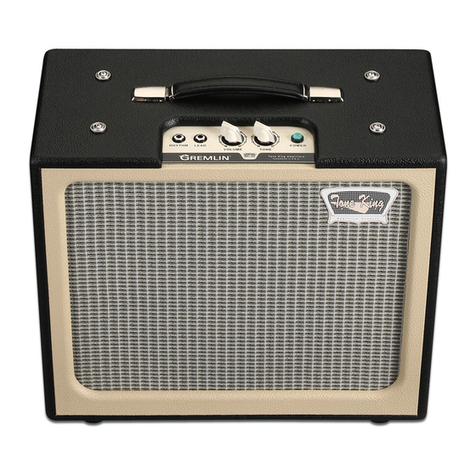
Tone King
Tone King Gremlin User manual

Tone King
Tone King Imperial User manual

Tone King
Tone King Tone King "Sky King" User manual

Tone King
Tone King Galaxy User manual
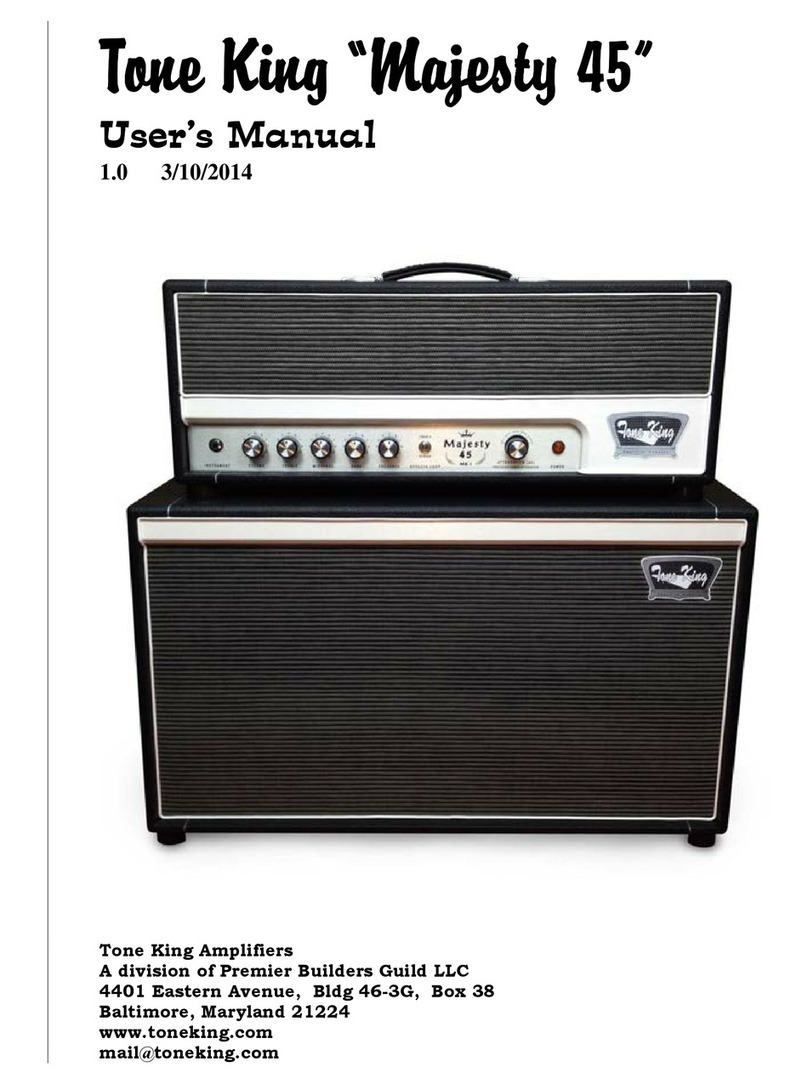
Tone King
Tone King Majesty 45 User manual

Tone King
Tone King FALCON User manual
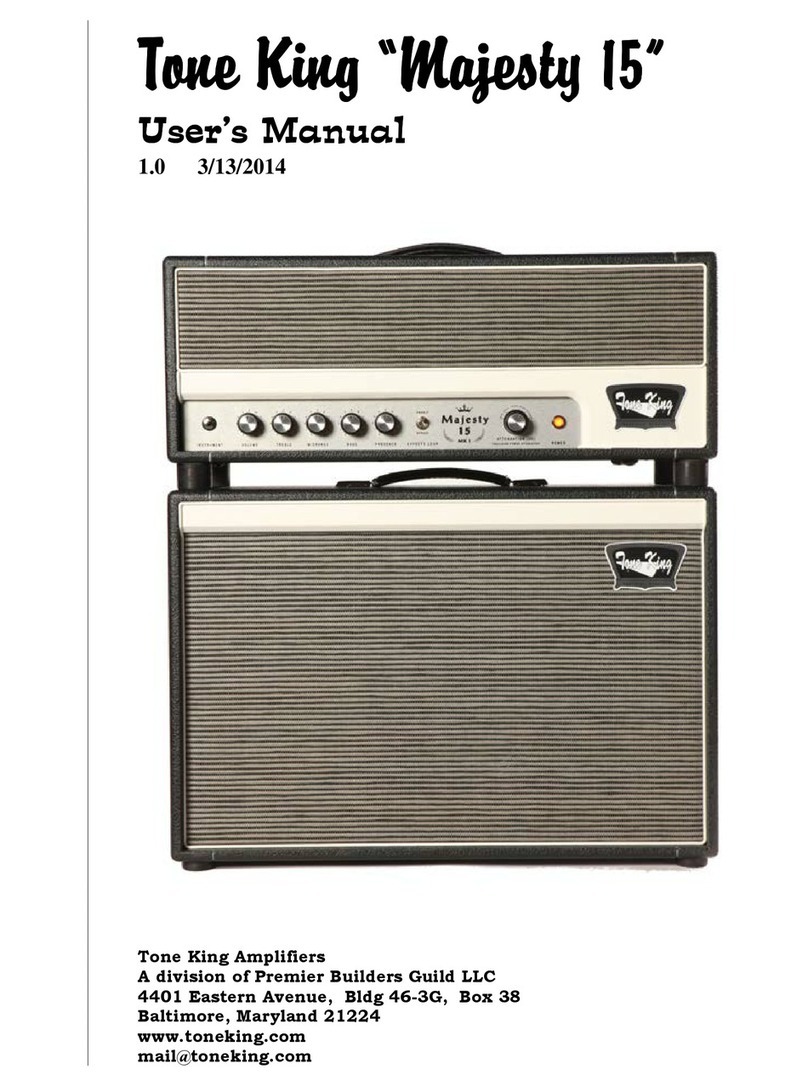
Tone King
Tone King Majesty 15 User manual
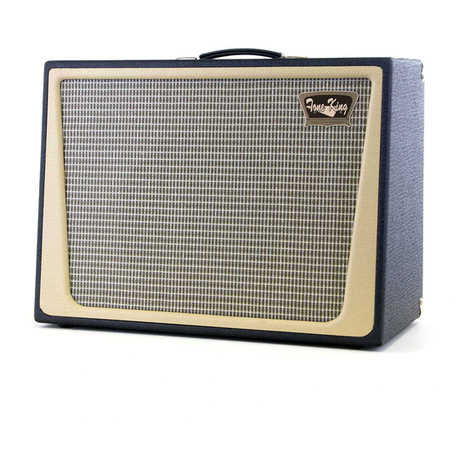
Tone King
Tone King Metropolitan User manual

Tone King
Tone King Falcon Grande User manual
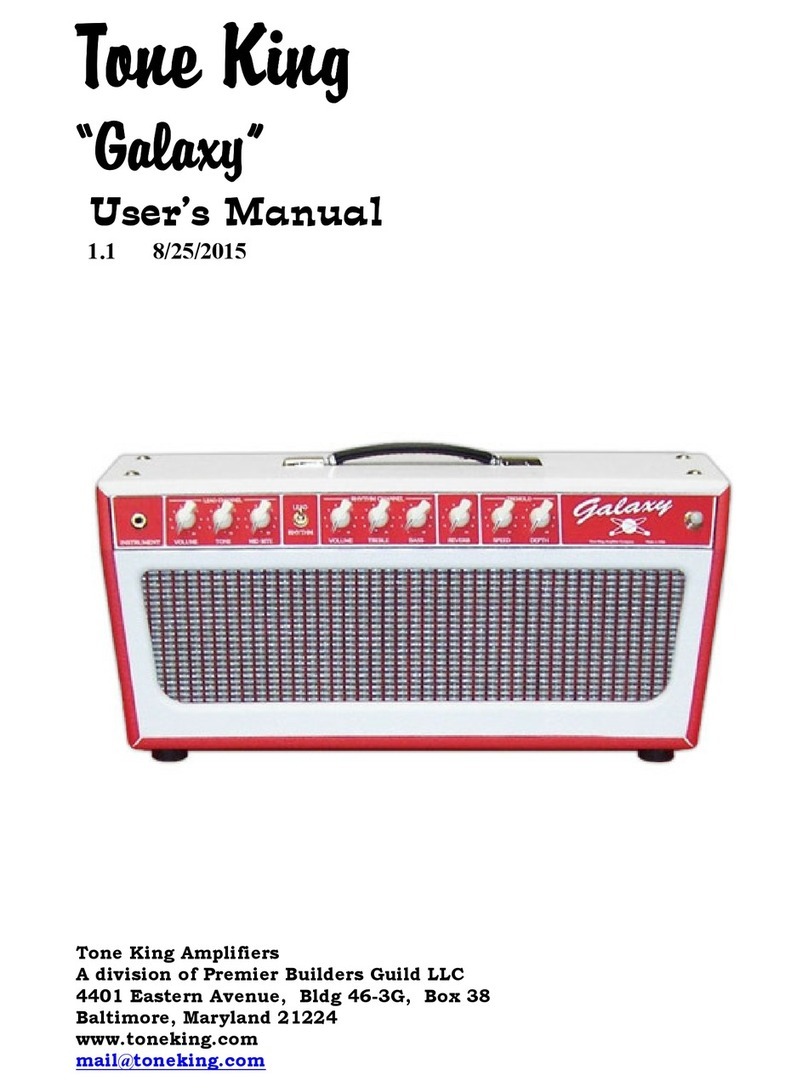
Tone King
Tone King Galaxy User manual
